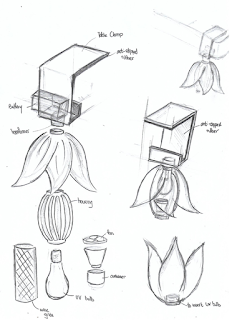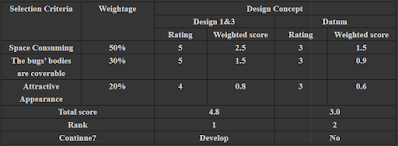- More formally known as an electric insect-control system or electrical-discharge insect-control system.
- A device that attracts and kills flying insects that are attracted by light.
- Works by attracting bugs and insects to the violet and ultra-violet light emitted by the lamp and then electrocutes them.
- Major parts in a bug zapper: Housing, UV/ Fluorescent Light Source, Wire Gauze and Transformer.
- Bug Zapper on the table will consume space
- The food on the table might contaminated
- But most of the bug zappers that we can see at the MAMAK's restaurants were installed far from the critical zone (such as under the table)
- saving the space of the table
- preventing diseases
- High aesthetic value
- Have hanger to clamp at the edge of table
- Have trapper to cover bugs’ dead bodies
- Have trapper to fill mosquito attractant
- Hard to clean
- Consume storage space
- Not all the table are suitable to clamp
- Trapper is small
- Easy to store and clean
- Safe to use
- Have trapper to fill mosquito attractant
- Have trapper to cover bugs’ dead bodies
- Have hanger to clamp at the edge of table
- Not all the table are suitable to clamp
- Easy to store
- The bugs and mosquitoes dead bodies are covered
- Safe to use
- No table clamp/hanger to clamp at the edge of the table
- Hard to clean the interior part
- No specific container to collect bugs and mosquitoes dead bodies
- Consume table space
Final Design Specification and Features
Part
/ Feature
|
Detail
|
Engineering
Parameter
|
Hanger cover
|
Function:
-
To hang the
Electric Bug Zapper at the end of table.
|
Material : ABS
Height : 50 mm
Length : 125 mm
Thickness : 1 mm
|
Trapper
|
Function:
-
To gather the
remains of bugs killed.
-
To fill
attractant for mosquitoes
|
Material : ABS
Height : 6.7 mm
Length : 125 mm
Thickness : 3.0 mm
|
Housing
|
Function:
-
To cover the electrical components.
|
Material : ABS
Height : 136mm
Length : 82 mm
Thickness : 2mm
|
Filter
|
Function:
-
To avoid bugs
from escaping from the zapper.
|
Material : ABS
Height : 15.8 mm
Length : 80 mm
Thickness : 1mm
|
Tenon-Mortise joint
|
Function:
-
Work as the joint
|
Material : ABS
Height : 3.4 mm
Diameter : 3.0 mm
|
- Has hanger to hang the bug zapper at the edge of the table for space saving
- Geometric cubic housing for modern aesthetics and easy for storage purpose
- Has half diamond-shaped filter to prevent the bugs from escaping
- Has non-transparent trapper to trap and hide the bugs’ dead bodies
- Has adjustable hanger so that the hanger can fit perfectly at any types of table
- Can be used for both light-attracted bugs and mosquitoes (mosquito does not attracted by light but attractant).
- Hygienic
- Safe to use
- Can be used for both bugs and mosquitoes
- Easy to store and clean
- Need refill the mosquito attractant from time to time
- Need remove the bugs’ dead bodies manually by removing the trapper
DIM
|
+ve
|
-ve
|
Tolerance
|
Dim1
|
136
|
0.1
|
|
Dim2
|
20.5
|
0.05
|
|
Dim3
|
113
|
0.05
|
|
Dim4
|
18
|
0.05
|
|
Dim5
|
15
|
0.05
|
|
Dim6
|
2.7
|
0.05
|
|
Total
|
136
|
134.5
|
0.35
|
Material
|
Environmental
impact
|
|||||
Carbon
Footprint
(Kg CO2)
|
Water
Eutrophication
(Kg PO4)
|
Air
Acidification
(Kg SO2)
|
Total Energy
Consumed (MJ)
|
Total
|
Percentage
(%)
|
|
ABS
|
0.747
|
4.3x10-4
|
4.5x10-3
|
13
|
13.8
|
57.02
|
PP
Copolymer
|
0.489
|
2.8x10-4
|
3.6x10-3
|
9.9
|
10.4
|
42.98
|
Total
|
24.2
|
100
|
||||
Storage in life cycle
|
Sustainability strategy
|
ABS
|
PP Copolymer
|
Stage 1:
Extraction and Manufacturing
|
Embodied
energy
|
Own
relatively high embodied energy per unit volume is needed to extract
material. Low processing energy to moulded material once extracted.
|
Own
relatively low embodied energy per unit volume is needed to extract material
as compare to other plastics. Higher processing energy to moulded material
once extracted.
|
Stage 2:
Product Use
|
Aesthetics
and durability
|
Excellent
aesthetic properties and easy to paint and glue. Durable, good strength and
stiffness, good fabricating and machining properties and process low heat
conductivity.
|
Attractive
and aesthetically appealing, excellent strength, toughness and flexibility
over a wide range of temperatures. Excellent impact strength resistance and
good elasticity.
|
Stage 3:
End of life
|
Disassemble
and Recyclability
|
Machines
with ease, low coefficient of friction, corrosion and abrasion resistant,
good chemical resistance and can be recycle
|
Recyclable.
PP Copolymer tends to have better stress crack resistance and low temperature
toughness than homo-polymer at the expense of quite small reductions in other
properties.
|
Part
/ Feature
|
Material
|
Quantity
|
Price
per Unit ($)
|
Total
Amount ($)
|
Hanger
|
ABS
|
1
|
0.50
|
0.50
|
Trapper
|
ABS
|
1
|
1.00
|
1.00
|
Housing frame
|
ABS
|
1
|
2.50
|
2.50
|
Filter
|
ABS
|
1
|
1.00
|
1.00
|
Connector
|
ABS
|
2
|
0.20
|
0.40
|
Wire Gauze
|
Stainless Steel
|
1
|
1.00
|
1.00
|
Ultraviolet Light
|
Borosilicate glass
|
1
|
2.50
|
2.50
|
Tenon-Mortise joint
|
Stainless steel
|
12
|
0.10
|
1.2
|
Transformer
|
Silicon steel
|
1
|
3.00
|
3.00
|
Cable (1m)
|
Conductor: Copper
PVC
|
1
|
1.50
|
1.50
|
Plug
|
ABS
|
1
|
0.50
|
0.50
|
Total
|
23
|
13.80
|
15.1
|
|
For the Electric Bug Zapper, the performance of the new design was being compared with the original design based in the current market. A 100% Safe Electric Bug Zapper, no chemicals or potentially harmful sprays to human were embedded in the product. With a size of 81mm x 52mm x 12.8 mm, a single high intensity LED UV bulb, a power voltage of 110V AC, 50 Hz and average power consumption of 2.5 W, the bug zapper is perfect for taking along during travel due to the compact size.
The Electric Bug Zapper was designed by using ABS and PP plastics, the zapper have high endurance even when it falls to the ground. Using an adapter as power source, the zapper can lasts for 4 hours in use without overheating. When the zapper is in operation, the amount of noise is reduced compare to other bug zapper.
The Bug Zapper offers a good after sales service, a 1-year warranty was provided for this product and the damage done within those period are claimable. Featuring a bright LED UV bulb that attract mosquito then make contact with an extremely powerful high voltage electrically charged metal grid, instantly killing them.
Electric Bug Zapper committed to comply with the standards imposed by the Restriction of Hazardous Substances Directive, which restricts the use of certain hazardous substances in electrical equipment. It is also complies with the standards imposed by the Conformance European (CE), a division of the Interfek group.
The Electric Bug Zapper is equipped with a trapper that is designed to keep dead mosquitoes and other insects collected inside the unit, which can then be easily removed for cleaning and bug disposal by gently shaking them. Available in the colour black, the bug zapper appears to look modern and simple and is easy to carry and use. Just clamp the device onto any table and it’s good to go. The effective coverage is about 20 square meters.
Electric Bug Zapper is powerful but quiet with PCB design which proves that the product eco-friendly. There is no harmful radiation, non-toxic quiet and safe to humans and pets. The product is recommended for outdoor use, particularly at restaurants that have outdoor dining tables. It also have low power consumption when it is in active-off mode. Due to electric shock danger, the users were advised not to touch the high voltage grids when in use and keep it away from children.




































